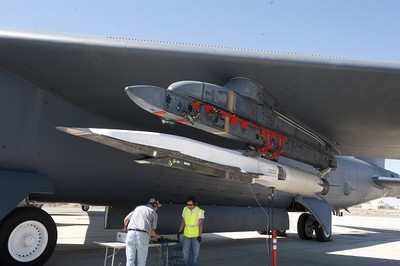Fri, Jun 17, 2011
Scramjet Failed To Develop Full Power
A second test of the X-51A Waverider flew June 13, 2011, in the
Point Mugu Naval Air Test Range over the Pacific Ocean, bringing
significant hypersonic research data in a less than successful
flight test. The hypersonic aircraft was successfully boosted to
just over Mach 5, and the scramjet engine lit but failed to
transition to full power.

Air Force Flight Test Center officials said after a flawless
flight from Edwards Air Force Base, a U.S. Air Force B-52H
Stratofortress released the experimental vehicle from an altitude
of approximately 50,000 feet. After release the X-51A was initially
accelerated by a solid rocket booster to a speed just over Mach
5.
The experimental aircraft's air breathing scramjet engine lit on
ethylene and attempted to transition to JP7 fuel operation when the
vehicle experienced an inlet un-start. The Waverider attempted to
restart and oriented itself to optimize engine start conditions but
was unsuccessful. The vehicle continued in a controlled flight
orientation until it flew into the ocean within the test range.

According to Charlie Brink, the Air Force Research Laboratory's
X-51A program manager, AFRL, Boeing and Pratt-Whitney Rocketdyne
engineers are reviewing the large amount of telemetry data
collected during the test flight to identify the cause of the
anomaly. "Obviously we're disappointed and expected better
results," said Mr. Brink, "but we are very pleased with the data
collected on this flight. I am extremely pleased with the AFFTC and
Point Mugu's support and execution of this complex flight test
mission, as they provided us every opportunity for success in this
endeavor. We have attempted two scramjet experiments now where one
successfully lit, and one did not. We will continue to examine the
data to learn even more about this new technology," he said. "Every
time we test this new and exciting technology, we get that much
closer to success."
Boeing and Pratt-Whitney Rocketdyne built four X-51A flight test
vehicles with the program goal of reaching Mach 6 in hypersonic
flight. The next flight is tentatively schedule for fall 2011.
More News
DETRESFA (Distress Phrase) The code word used to designate an emergency phase wherein there is reasonable certainty that an aircraft and its occupants are threatened by grave and i>[...]
"General aviation is at the forefront of developing and introducing innovative technologies that will transform the entire aviation industry..." Source: Kyle Martin, Vice President>[...]
Direct Straight line flight between two navigational aids, fixes, points, or any combination thereof. When used by pilots in describing off-airway routes, points defining direct ro>[...]
Aero Linx: Women in Corporate Aviation Women in Corporate Aviation support individuals seeking career advancement and professional development in the business aviation industry. Me>[...]
“We would like to thank the many volunteers that help throughout the year to pull off the event, as well as the several reviewers, judges, and SURVICE staff that provide team>[...]
 ANN's Daily Aero-Term (04.26.24): DETRESFA (Distress Phrase)
ANN's Daily Aero-Term (04.26.24): DETRESFA (Distress Phrase) Aero-News: Quote of the Day (04.26.24)
Aero-News: Quote of the Day (04.26.24) ANN's Daily Aero-Term (04.27.24): Direct
ANN's Daily Aero-Term (04.27.24): Direct ANN's Daily Aero-Linx (04.27.24)
ANN's Daily Aero-Linx (04.27.24) Aero-News: Quote of the Day (04.27.24)
Aero-News: Quote of the Day (04.27.24)




